RENAULT SCENIC 2008 J84 / 2.G Multimedia ITS Workshop Manual
Manufacturer: RENAULT, Model Year: 2008, Model line: SCENIC, Model: RENAULT SCENIC 2008 J84 / 2.GPages: 71
Page 1 of 71
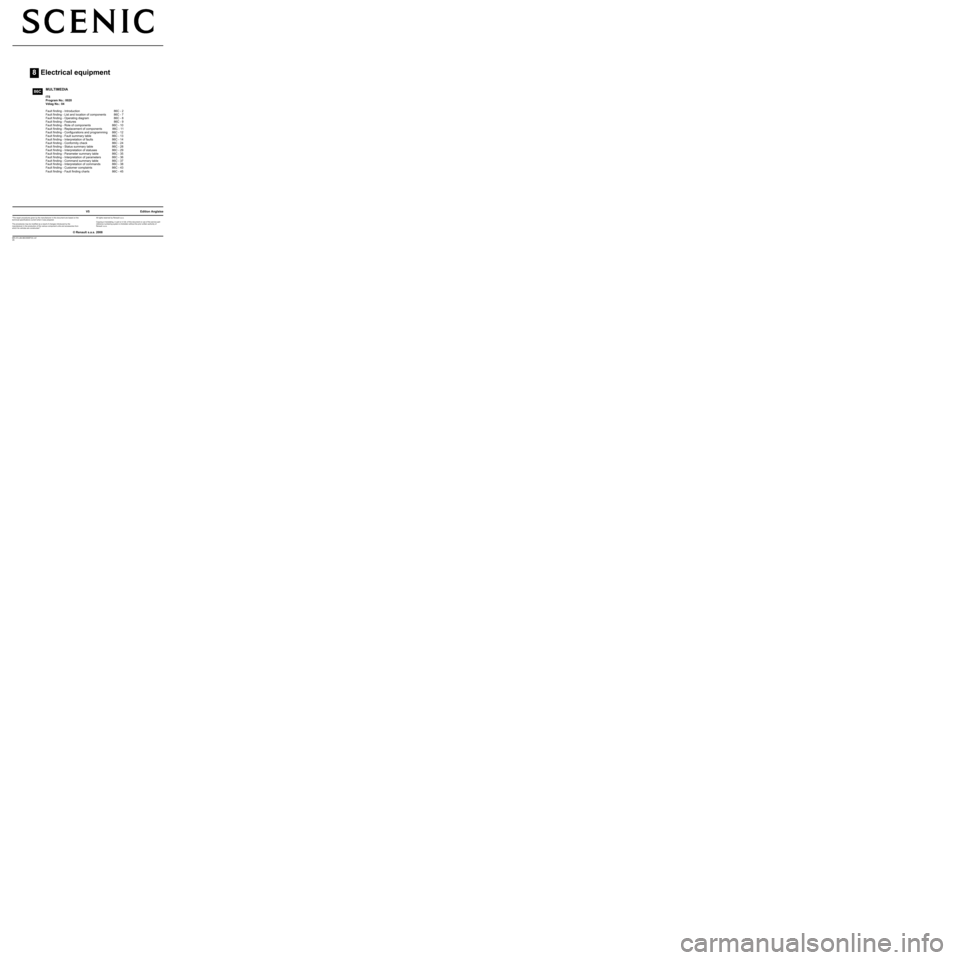
8Electrical equipment
V5 MR-372-J84-86C050$TOC.mif
V5
86C
"The repair procedures given by the manufacturer in this document are based on the
technical specifications current when it was prepared.
The procedures may be modified as a result of changes introduced by the
manufacturer in the production of the various component units and accessories from
which his vehicles are constructed."
V5
All rights reserved by Renault s.a.s.
Edition Anglaise
Copying or translating, in part or in full, of this document or use of the service part
reference numbering system is forbidden without the prior written authority of
Renault s.a.s.
© Renault s.a.s. 2008
MULTIMEDIA
ITS
Program No.: 0020
Vdiag No.: 04
Fault finding - Introduction 86C - 2
Fault finding - List and location of components 86C - 7
Fault finding - Operating diagram 86C - 8
Fault finding - Features 86C - 9
Fault finding - Role of components 86C - 10
Fault finding - Replacement of components 86C - 11
Fault finding - Configurations and programming 86C - 12
Fault finding - Fault summary table 86C - 13
Fault finding - Interpretation of faults 86C - 14
Fault finding - Conformity check 86C - 24
Fault finding - Status summary table 86C - 28
Fault finding - Interpretation of statuses 86C - 29
Fault finding - Parameter summary table 86C - 35
Fault finding - Interpretation of parameters 86C - 36
Fault finding - Command summary table 86C - 37
Fault finding - Interpretation of commands 86C - 38
Fault finding - Customer complaints 86C - 43
Fault finding - Fault finding charts 86C - 45
Page 2 of 71
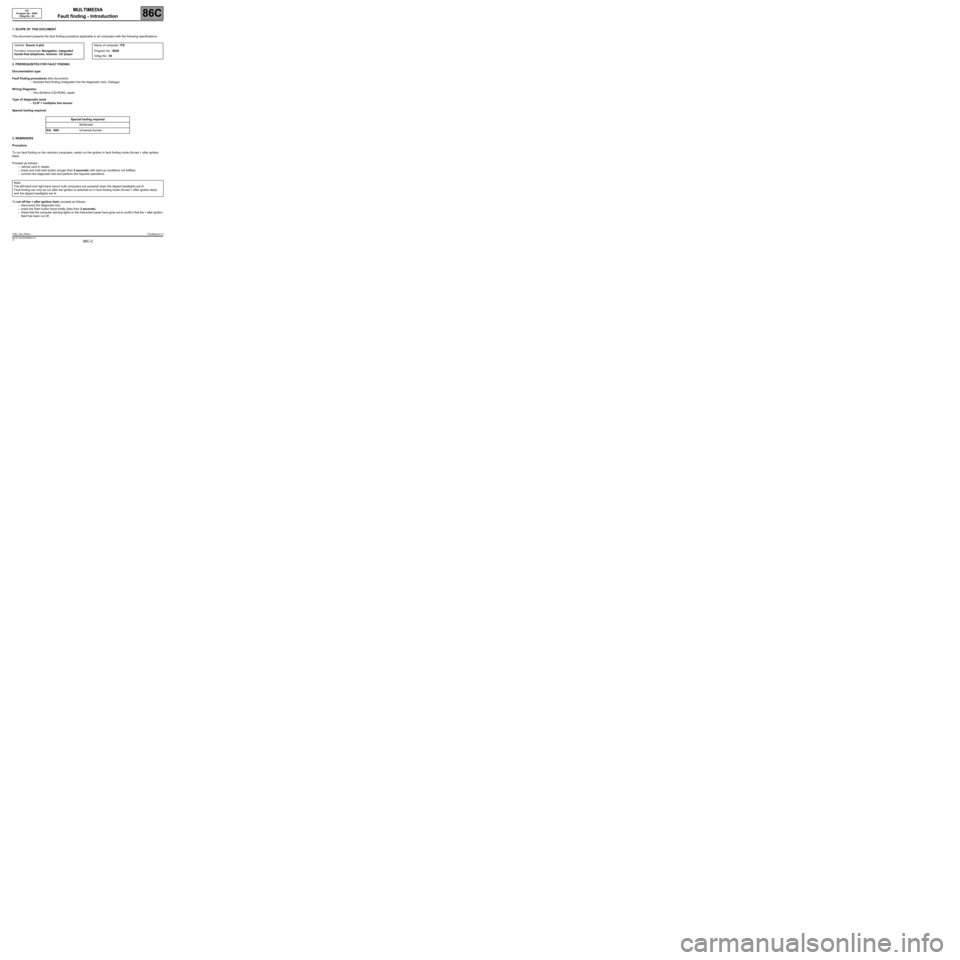
MULTIMEDIA
Fault finding - Introduction
86C
86C-2V5 MR-372-J84-86C050$052.mif
186C
ITS
Program No.: 0020
Vdiag No.: 04MULTIMEDIA
Fault finding - Introduction
1. SCOPE OF THIS DOCUMENT
This document presents the fault finding procedure applicable to all computers with the following specifications:
2. PREREQUISITES FOR FAULT FINDING
Documentation type
Fault finding procedures (this document):
–Assisted fault finding (integrated into the diagnostic tool), Dialogys.
Wiring Diagrams:
–Visu-Schéma (CD-ROM), paper.
Type of diagnostic tools
–CLIP + multiplex line sensor
Special tooling required
3. REMINDERS
Procedure
To run fault finding on the vehicle's computers, switch on the ignition in fault finding mode (forced + after ignition
feed).
Proceed as follows:
–vehicle card in reader,
–press and hold start button (longer than 5 seconds) with start-up conditions not fulfilled,
–connect the diagnostic tool and perform the required operations.
To cut off the + after ignition feed, proceed as follows:
–disconnect the diagnostic tool,
–press the Start button twice briefly (less than 3 seconds),
–check that the computer warning lights on the instrument panel have gone out to confirm that the + after ignition
feed has been cut off. Vehicle: Scenic II ph2
Function concerned: Navigation, integrated
hands-free telephone, receiver, CD playerName of computer: ITS
Program No.: 0020
Vdiag No.: 04
Special tooling required
Multimeter
Elé. 1681Universal bornier
Note:
The left-hand and right-hand xenon bulb computers are powered when the dipped headlights are lit.
Fault finding can only be run after the ignition is switched on in fault finding mode (forced + after ignition feed)
and the dipped headlights are lit.
TDB_V04_PRELIITSJ84ph2V1.0
MR-372-J84-86C050$052.mif
Page 3 of 71
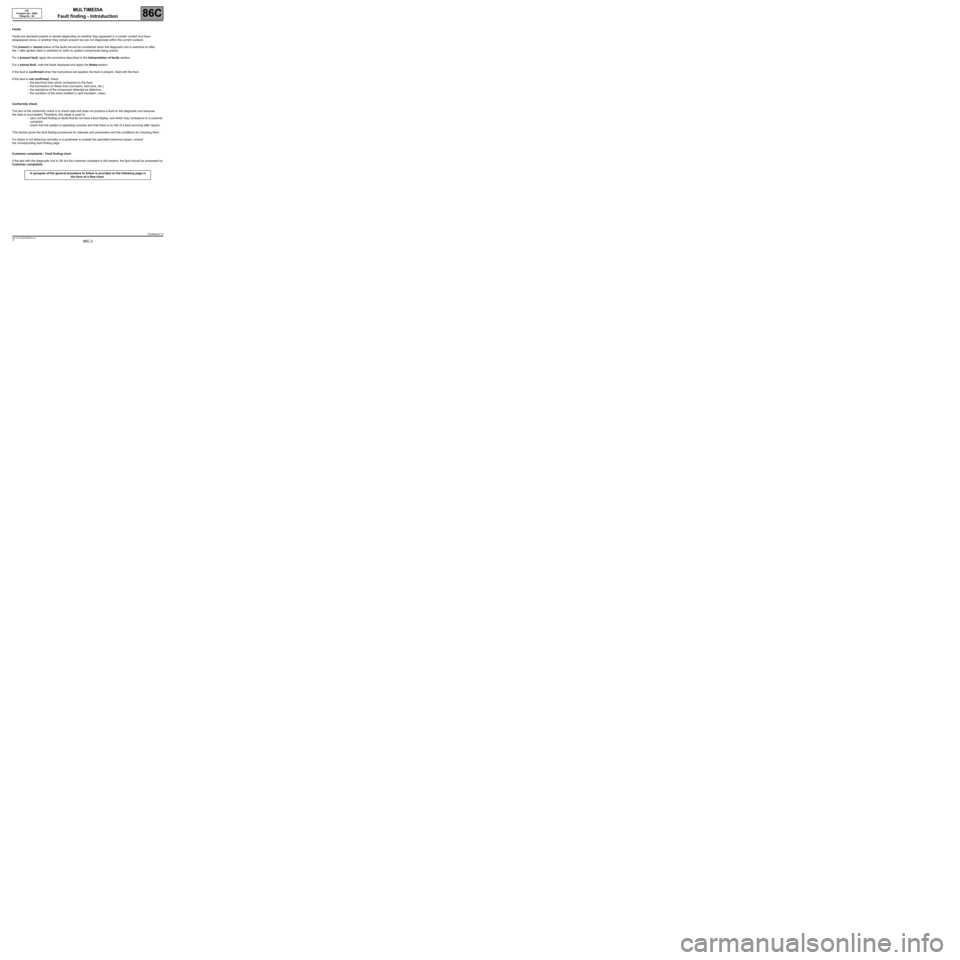
MULTIMEDIA
Fault finding - Introduction
86C
86C-3V5 MR-372-J84-86C050$052.mif
ITS
Program No.: 0020
Vdiag No.: 04
Faults
Faults are declared present or stored (depending on whether they appeared in a certain context and have
disappeared since, or whether they remain present but are not diagnosed within the current context).
The present or stored status of the faults should be considered when the diagnostic tool is switched on after
the + after ignition feed is switched on (with no system components being active).
For a present fault, apply the procedure described in the Interpretation of faults section.
For a stored fault, note the faults displayed and apply the Notes section.
If the fault is confirmed when the instructions are applied, the fault is present. Deal with the fault.
If the fault is not confirmed, check:
–the electrical lines which correspond to the fault,
–the connectors on these lines (corrosion, bent pins, etc.),
–the resistance of the component detected as defective,
–the condition of the wires (melted or split insulation, wear).
Conformity check
The aim of the conformity check is to check data that does not produce a fault on the diagnostic tool because
the data is inconsistent. Therefore, this stage is used to:
–carry out fault finding on faults that do not have a fault display, and which may correspond to a customer
complaint.
–check that the system is operating correctly and that there is no risk of a fault recurring after repairs.
This section gives the fault finding procedures for statuses and parameters and the conditions for checking them.
If a status is not behaving normally or a parameter is outside the permitted tolerance values, consult
the corresponding fault finding page.
Customer complaints - Fault finding chart
If the test with the diagnostic tool is OK but the customer complaint is still present, the fault should be processed by
Customer complaints.
A synopsis of the general procedure to follow is provided on the following page in
the form of a flow chart.
ITSJ84ph2V1.0
Page 4 of 71
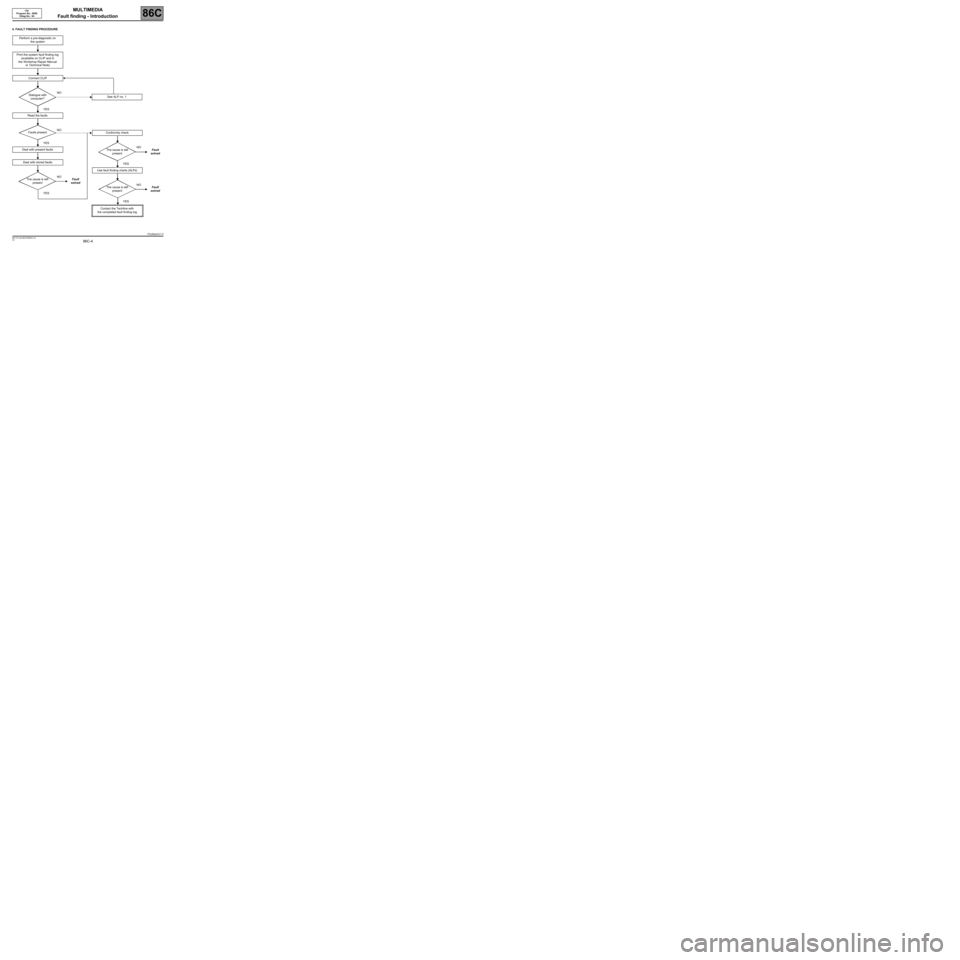
MULTIMEDIA
Fault finding - Introduction
86C
86C-4V5 MR-372-J84-86C050$052.mif
ITS
Program No.: 0020
Vdiag No.: 04
4. FAULT FINDING PROCEDURE
Perform a pre-diagnostic on
the system
Print the system fault finding log
(available on CLIP and in
the Workshop Repair Manual
or Technical Note)
Connect CLIP
NO
Dialogue with
computer?
YES
Read the faults
NO
Faults present
YES
Deal with present faults
Deal with stored faults
NO
The cause is still
presentFault
solved
YES
See ALP no. 1
Conformity check
NO
The cause is still
presentFault
solved
YES
Use fault finding charts (ALPs)
NO
The cause is still
presentFault
solved
YES
Contact the Techline with
the completed fault finding log
ITSJ84ph2V1.0
Page 5 of 71
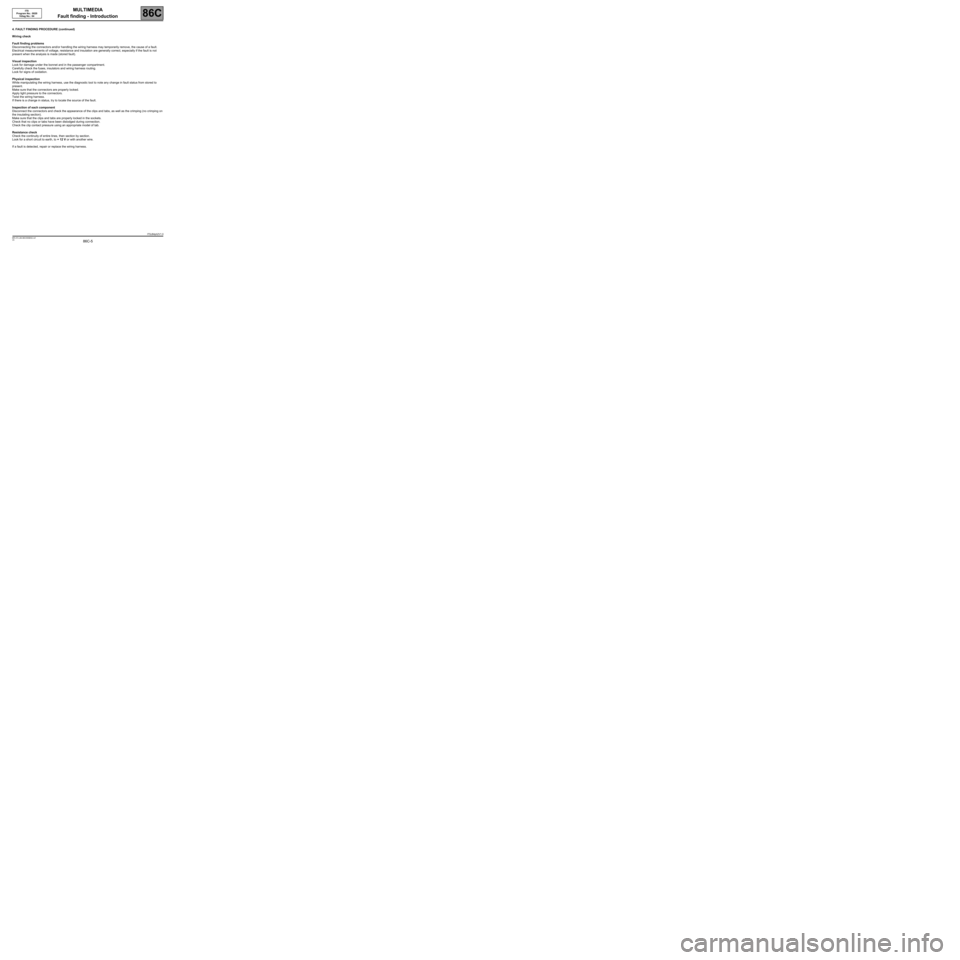
MULTIMEDIA
Fault finding - Introduction
86C
86C-5V5 MR-372-J84-86C050$052.mif
ITS
Program No.: 0020
Vdiag No.: 04
4. FAULT FINDING PROCEDURE (continued)
Wiring check
Fault finding problems
Disconnecting the connectors and/or handling the wiring harness may temporarily remove, the cause of a fault.
Electrical measurements of voltage, resistance and insulation are generally correct, especially if the fault is not
present when the analysis is made (stored fault).
Visual inspection
Look for damage under the bonnet and in the passenger compartment.
Carefully check the fuses, insulators and wiring harness routing.
Look for signs of oxidation.
Physical inspection
While manipulating the wiring harness, use the diagnostic tool to note any change in fault status from stored to
present.
Make sure that the connectors are properly locked.
Apply light pressure to the connectors.
Twist the wiring harness.
If there is a change in status, try to locate the source of the fault.
Inspection of each component
Disconnect the connectors and check the appearance of the clips and tabs, as well as the crimping (no crimping on
the insulating section).
Make sure that the clips and tabs are properly locked in the sockets.
Check that no clips or tabs have been dislodged during connection.
Check the clip contact pressure using an appropriate model of tab.
Resistance check
Check the continuity of entire lines, then section by section.
Look for a short circuit to earth, to + 12 V or with another wire.
If a fault is detected, repair or replace the wiring harness.
ITSJ84ph2V1.0
Page 6 of 71
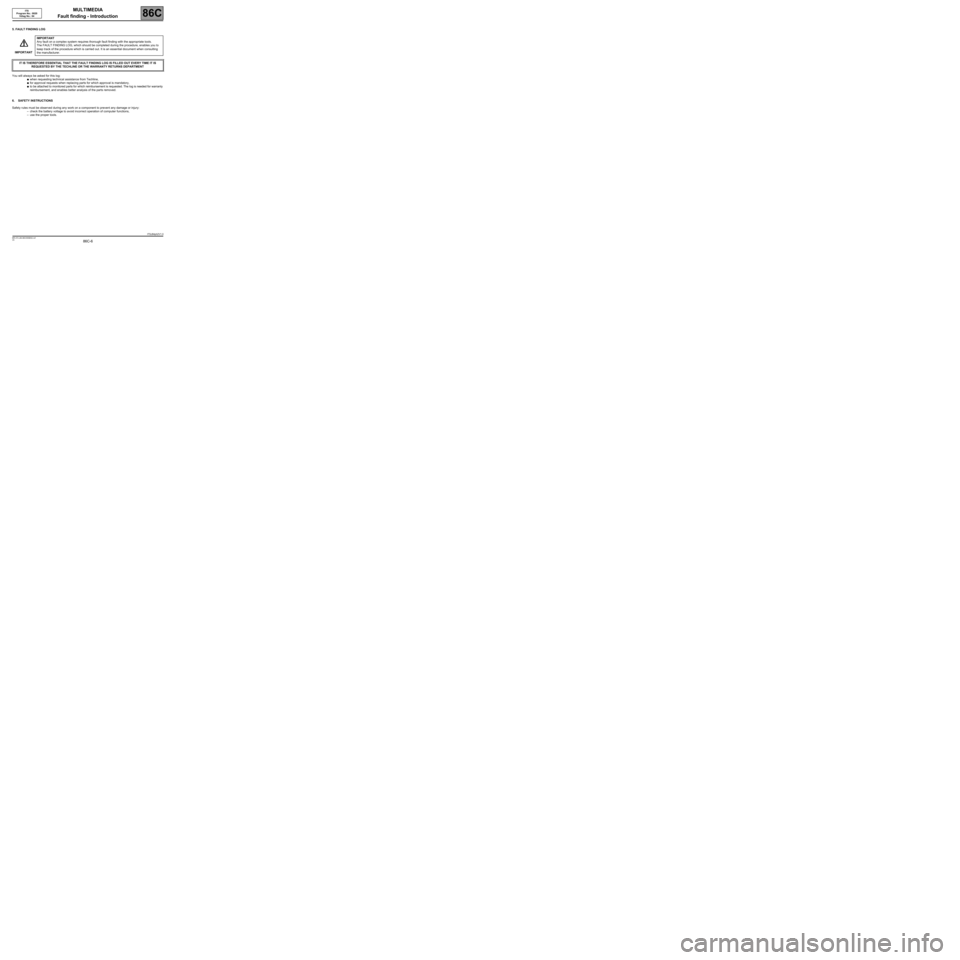
MULTIMEDIA
Fault finding - Introduction
86C
86C-6V5 MR-372-J84-86C050$052.mif
ITS
Program No.: 0020
Vdiag No.: 04
5. FAULT FINDING LOG
You will always be asked for this log:
●when requesting technical assistance from Techline,
●for approval requests when replacing parts for which approval is mandatory,
●to be attached to monitored parts for which reimbursement is requested. The log is needed for warranty
reimbursement, and enables better analysis of the parts removed.
6. SAFETY INSTRUCTIONS
Safety rules must be observed during any work on a component to prevent any damage or injury:
–check the battery voltage to avoid incorrect operation of computer functions,
–use the proper tools. IMPORTANTIMPORTANT
Any fault on a complex system requires thorough fault finding with the appropriate tools.
The FAULT FINDING LOG, which should be completed during the procedure, enables you to
keep track of the procedure which is carried out. It is an essential document when consulting
the manufacturer.
IT IS THEREFORE ESSENTIAL THAT THE FAULT FINDING LOG IS FILLED OUT EVERY TIME IT IS
REQUESTED BY THE TECHLINE OR THE WARRANTY RETURNS DEPARTMENT
ITSJ84ph2V1.0
Page 7 of 71
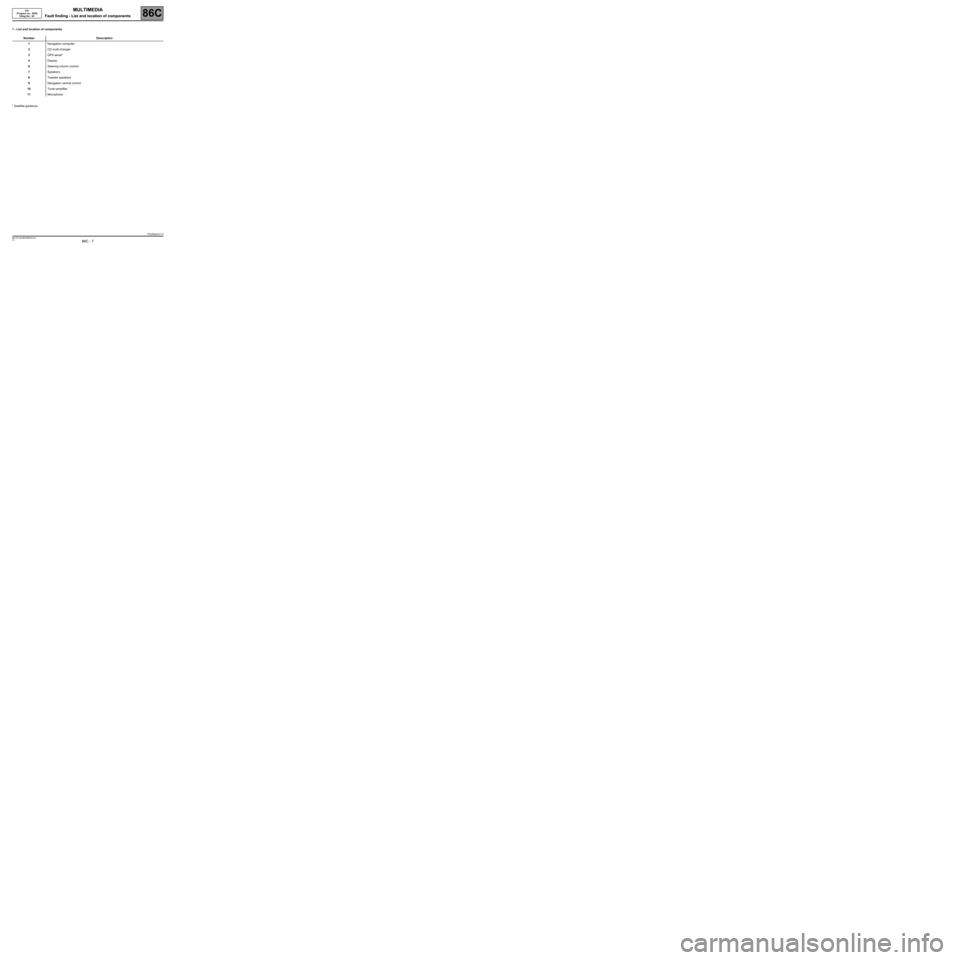
MULTIMEDIA
Fault finding - List and location of components86C
86C - 7V5 MR-372-J84-86C050$104.mif
ITS
Program no.: 0020
Vdiag No.: 04MULTIMEDIA
Fault finding - List and location of components
1 - List and location of components
* Satellite guidanceNumber Description
1Navigation computer
2CD multi-changer
3GPS aerial*
4Display
6Steering column control
7Speakers
8Tweeter speakers
9Navigation central control
10Tuner-amplifier
11Microphone
ITSJ84ph2V1.0
MR-372-J84-86C050$104.mif
Page 8 of 71
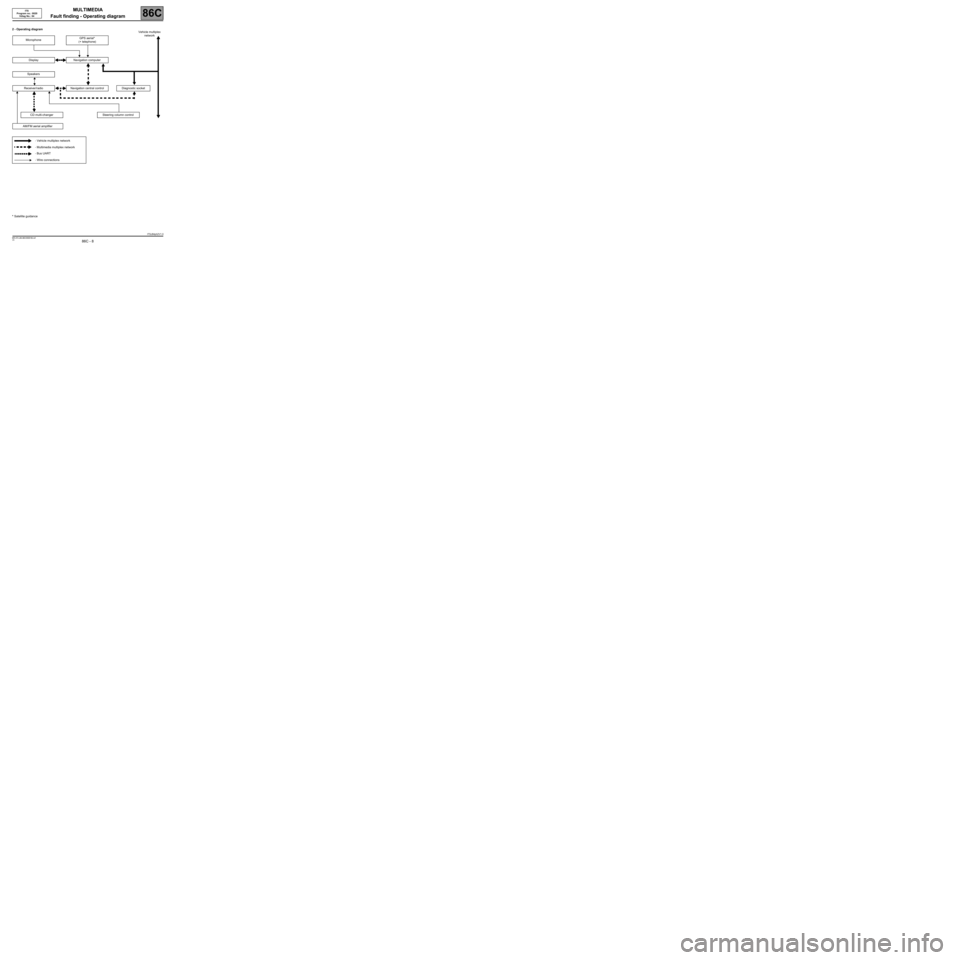
MULTIMEDIA
Fault finding - Operating diagram
86C
86C - 8V5 MR-372-J84-86C050$156.mif
ITS
Program no.: 0020
Vdiag No.: 04MULTIMEDIA
Fault finding - Operating diagram
2 - Operating diagram
MicrophoneGPS aerial*
(+ telephone)
Display Navigation computer
Speakers
Receiver/radio Navigation central control Diagnostic socket
CD multi-changer Steering column control
AM/FM aerial amplifier
- Vehicle multiplex network
- Multimedia multiplex network
- Bus UART
- Wire connectionsVehicle multiplex
network
* Satellite guidance
ITSJ84ph2V1.0
MR-372-J84-86C050$156.mif
Page 9 of 71
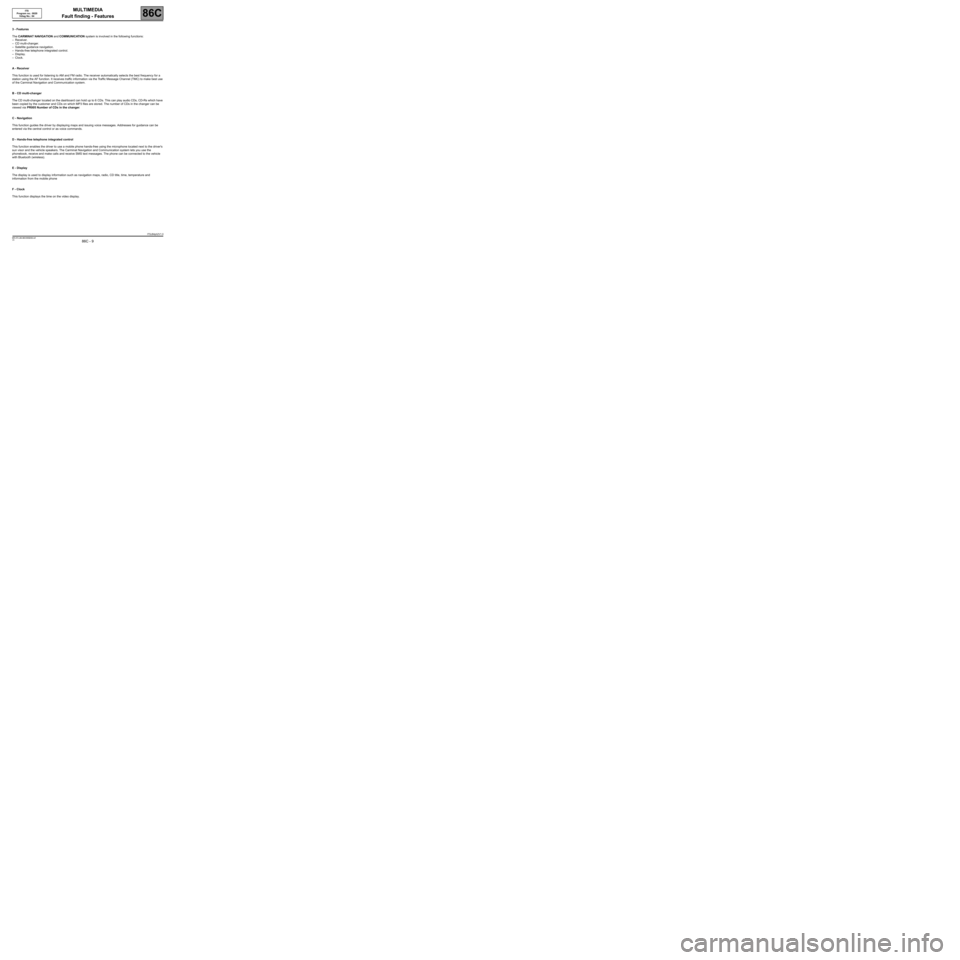
MULTIMEDIA
Fault finding - Features
86C
86C - 9V5 MR-372-J84-86C050$208.mif
ITS
Program no.: 0020
Vdiag No.: 04MULTIMEDIA
Fault finding - Features
3 - Features
The CARMINAT NAVIGATION and COMMUNICATION system is involved in the following functions:
–Receiver.
–CD multi-changer.
–Satellite guidance navigation.
–Hands-free telephone integrated control.
–Display.
–Clock.
A - Receiver
This function is used for listening to AM and FM radio. The receiver automatically selects the best frequency for a
station using the AF function. It receives traffic information via the Traffic Message Channel (TMC) to make best use
of the Carminat Navigation and Communication system.
B - CD multi-changer
The CD multi-changer located on the dashboard can hold up to 6 CDs. This can play audio CDs, CD-Rs which have
been copied by the customer and CDs on which MP3 files are stored. The number of CDs in the changer can be
viewed via PR005 Number of CDs in the changer.
C - Navigation
This function guides the driver by displaying maps and issuing voice messages. Addresses for guidance can be
entered via the central control or as voice commands.
D - Hands-free telephone integrated control
This function enables the driver to use a mobile phone hands-free using the microphone located next to the driver's
sun visor and the vehicle speakers. The Carminat Navigation and Communication system lets you use the
phonebook, receive and make calls and receive SMS text messages. The phone can be connected to the vehicle
with Bluetooth (wireless).
E - Display
The display is used to display information such as navigation maps, radio, CD title, time, temperature and
information from the mobile phone
F - Clock
This function displays the time on the video display.
ITSJ84ph2V1.0
MR-372-J84-86C050$208.mif
Page 10 of 71
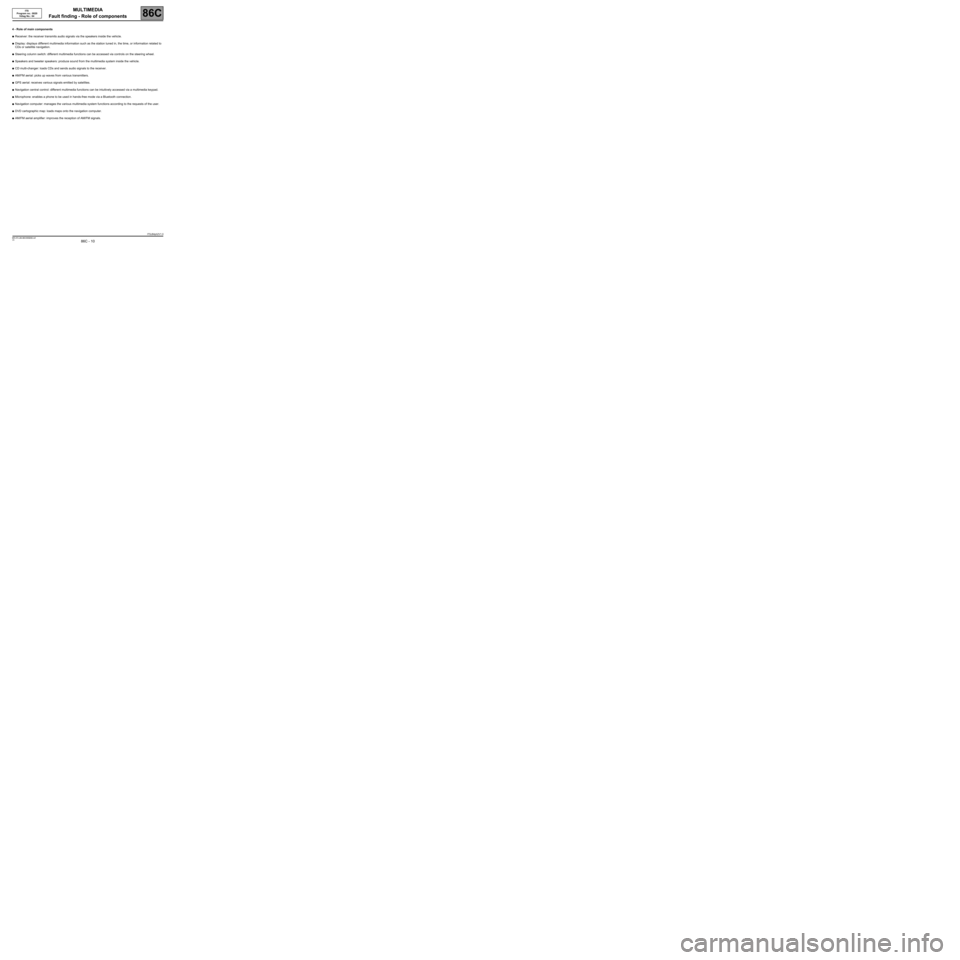
MULTIMEDIA
Fault finding - Role of components
86C
86C - 10V5 MR-372-J84-86C050$260.mif
ITS
Program no.: 0020
Vdiag No.: 04MULTIMEDIA
Fault finding - Role of components
4 - Role of main components
●Receiver: the receiver transmits audio signals via the speakers inside the vehicle.
●Display: displays different multimedia information such as the station tuned in, the time, or information related to
CDs or satellite navigation.
●Steering column switch: different multimedia functions can be accessed via controls on the steering wheel.
●Speakers and tweeter speakers: produce sound from the multimedia system inside the vehicle.
●CD multi-changer: loads CDs and sends audio signals to the receiver.
●AM/FM aerial: picks up waves from various transmitters.
●GPS aerial: receives various signals emitted by satellites.
●Navigation central control: different multimedia functions can be intuitively accessed via a multimedia keypad.
●Microphone: enables a phone to be used in hands-free mode via a Bluetooth connection.
●Navigation computer: manages the various multimedia system functions according to the requests of the user.
●DVD cartographic map: loads maps onto the navigation computer.
●AM/FM aerial amplifier: improves the reception of AM/FM signals.
ITSJ84ph2V1.0
MR-372-J84-86C050$260.mif